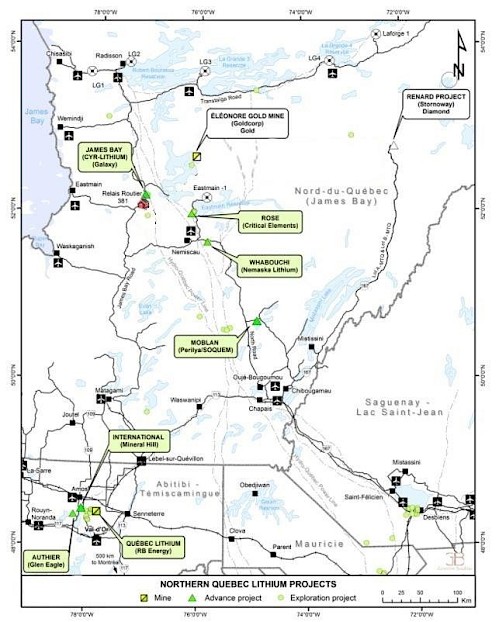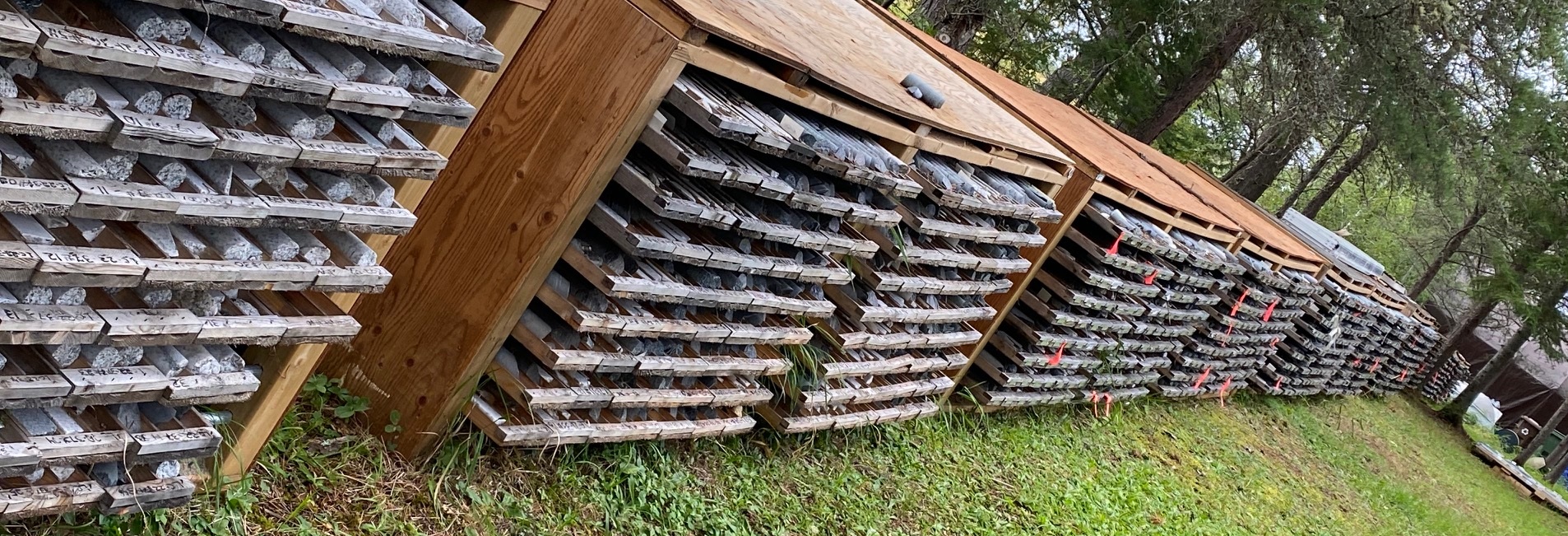The Augustus Lithium Property covers a large area of spodumene Lithium bearing pegmatites in one of the world’s best mining jurisdictions, Quebec. The property consists of over 700 mining claims covering a total area of over 27,000 hectares surrounding the mining hub of Val d’Or. It has excellent infrastructure support with road network, railway, electricity, water, and trained manpower available locally.
The Property is located in a very active hard rock lithium pegmatite area. There are several historical and currently active lithium and molybdenum prospects/mines located approximately 3 km to 20 km from the Property. Two notable projects include North American Lithium (NAL) and Authier Lithium both of which are owned by Sayona Mining of Australia. Total lithium resource for both NAL and Authier currently sits at 87,815,000 tonnes at 1.05 Li2O% Measured plus Indicated (M+I) and 31,242, 000 tonnes at 1.07 Li2O% Inferred Category. (https://sayonamining.com.au/wp/wp-content/uploads/2022/03/SYA_Doubling-resource-base_1-Mar-22.pdf)

GEOLOGY AND MINERALIZATION
The geology and the mineralization of the Augustus Property are similar to the geology and mineralization of North American Lithium Mine(NAL) located approximately 7 kilometers to the southeast of the Property. Geologically the Preissac-Lacorne area lies within a belt of volcanic and sedimentary rocks intruded to the north by LaMotte batholiths and to the south by the Preissac batholiths and Moly Hill pluton.
There are two prominent lithium prospects (Augustus and Canadian Lithium) and one silver prospect on the property which have been explored intermittently since 1948.
- Augustus Lithium Project
- Canadian Lithium Project
- Landrienne Sud Silver Project
Highlights of these prospects are discussed below:
Augustus Lithium Project:
- The Augustus lithium pegmatite was explored in 1955 by trenching followed by diamond drilling. The host pegmatite is oriented N30°W, extending more than 850 meters along strike with 7.6 meters in average width. Its depth extension is not fully known yet, however previous drilling has intersected high-grade lithium down to 200 m. Lithium mineralization is confined to the pegmatite body with an average grade of 1.12% lithium oxide (Li2O) (0.52% Li) across a width of 7.6. meters (Source: Géologie Québec - Results of the query (gouv.qc.ca)). There are 18 documented historical drill holes completed since the 1950s’ on this prospect with a cumulative drilling of 3,626m. These holes have drilled depth range of 109m to 366m and intersected several high-grade lithium pegmatite intercepts.
- The highlights of the previous drilling results include:1.69% Li2O over 9 feet (2.74m), 1.25% Li2O over 27.5 feet (8.38m), 1.07% Li2O over 20 feet (6.1m), 1.66% Li2O over 12.5 feet (3.8m), and 1.41% Li2O over 27 feet (8.23m) (see Table 1 below) (Source Report GM03952).
- Based on the 1955 drilling results, the continuity of lithium mineralization is established between all drill holes for over 850 meters strike length down to a depth of 207 m (682 feet) of the Augustus pegmatite body.
Cautionary Statement: Investors are cautioned that the potential quantity and grade mentioned above is conceptual in nature, there has been insufficient exploration to define a mineral resource and it is uncertain if further exploration will result in the target being delineated as a mineral resource. The potential target is based upon historical drilling results taken from report GM03952 (April 27, 1956) and other sources from MRNF Quebec.
Canadian Lithium Project:
- The Canadian lithium prospect is a worked deposit located in Range 1 lot 25-26 in the Landrienne Township at G.P.S 284861 E - 5368288 N. The main outcrop was discovered in 1948 near the boundary line separating the Landrienne and Lacorne Townships. A group of parallel pegmatite dykes associated with Lacorne Batholith contains aggregates of spodumene, lepidolite, quartz and feldspar accompanied by traces of beryl, clevelandite, colombo-tantalite.
- Drilling at the prospect have shown low grade lithium bearing pegmatite intersections of extensive widths. A total of 14 historical drill holes are located on this prospect having drilled depths in the range of 26m to 184m and a cumulative drilling of 944m. Drill hole CL-39 (GM 03952) returned a grade of 0.59% over 2.9 m Li. It has been estimated that a section of 90.0 m by 30.0 m contains 5.0 to 10.0% lithium bearing spodumene. (Source Reports GM03952 and GM00744). This deposit represents a potential for low grade bulk tonnage of lithium pegmatite material.
- The highlights of historical drilling program are: 0.59% Li2O over 84.4 feet, 0.15% Li2O over 282 feet, 0.158% Li2O over 204.4 feet, 0.19% Li2O over 232.7 feet and 0.105% Li2O over 296.3 feet. Drilling results have proved lithium mineralization and grade continuity along the strike length (350 meters) of the pegmatite dyke.
Landrienne Silver Project:
- Silver mineralization occurs in quartz and carbonate veins intersecting felsic to mafic lavas and locally in massive sulphides. These volcanics belong to the Landrienne Formation. The mineralization is mainly in the form of sulphides (pyrite, chalcopyrite, pyrrhotite) disseminated in quartz and carbonate veins and also locally in the form of lenses of massive sulphides.
- Historical drilling documented for this prospect comprised of 30 drill holes over 6,000 m cumulative drilling.
- Report GM 02989-B: the best results obtained from the holes drilled in 1954 are 10.3 ppm silver over 0.8 meters, 11.7 ppm silver over 0.6 meters, 8.6 ppm silver over 0.6 meters, 9.6 ppm d silver over 0.6 meters, 2000 ppm copper over 1.5 meters, 1000 ppm copper over 0.6 meters, 8.6 ppm silver over 0.6 meters. GM 28244: a drilling carried out in 1972 returned 2000 ppm of copper over 2.6 meters. GM 66408: a selected sample yielded 36.8% iron.
Cautionary Statement: Investors are cautioned that the above information and the information on the adjacent properties is taken from the publicly available sources. The Company has not been able to independently verify the information contained. The information is not necessarily indicative of the mineralization on the Property, which is the subject of this report. The Company will need to conduct exploration to confirm historical mineralization reported on the property and there is no guarantee that significant discovery will be made as a result of its exploration efforts. The Company is in the process of compiling exploration and geological data available on the property and surrounding area to develop an exploration work plan.

